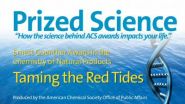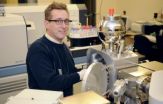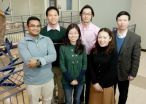(Press-News.org) WASHINGTON, Dec. 15, 2010 — The quest to cure a terrible form of food poisoning caused by population explosions of algae that stain the water red and produce a potent toxin is the topic of a new episode in the American Chemical Society (ACS) Prized Science video series.
Entitled "Taming the Red Tides," the high-definition video, released today, focuses on Michael Crimmins, Ph.D., winner of the 2010 Ernest Guenther Award in the Chemistry of Natural Products. Crimmins, a chemist at the University of North Carolina in Chapel Hill, studies brevetoxin A, a poison produced by red tide algae.
The video explains that red tides perhaps were first documented in the Book of Exodus in the Holy Bible: "…and all the waters that were in the [Nile] river were turned to blood. And the fish that was in the river died; and the river stank, and the Egyptians could not drink of the water of the river ..."
Red tides occur when certain algae "bloom" in enormous numbers, staining the water reddish brown. Toxins, or poisons, released by the algae periodically kill millions of fish, and cause billions of dollars in losses to the global commercial fishing industry.
Health officials ban fishing for oysters, shrimp and other shellfish ― if they detect a red tide. If not, unsuspecting consumers may get hit with a virtual tidal wave called neurotoxic shellfish or paralytic shellfish poisoning. The condition causes not just nausea and vomiting, but tingling of the mouth, arms and legs, poor coordination, and other unpleasant symptoms. The algae can also produce a toxic mist, swept along by the wind like fog. People along the beach or in ships can become sick simply by inhaling this contaminated sea mist. Crimmins and his colleagues have been gathering knowledge about brevetoxin A, and related toxins, essential for developing medicines to treat the poisoning.
"Taming the Red Tides" is the fourth episode in Prized Science: How the Science Behind ACS Awards Impacts Your Life, from the American Chemical Society (ACS), the world's largest scientific society. Rich with high-definition graphics and animations, and commentary suitable for classroom use and other audiences of students and non-scientists, the videos are available without charge at the Prized Science website, YouTube, iTunes and on DVD.
ACS encourages educators, schools, museums, science centers, news organizations, and others to embed links to Prized Science on their websites.
"Estimates suggest that more than 30,000 significant prizes ― most for scientific or medical research ― are awarded annually," noted ACS President Joseph S. Francisco, Ph.D. "For many of them, the spotlight of news media publicity rightly focuses on the recipients. Often lost behind the headlines, is an explanation of how the science honored in the award impacts the everyday lives of people throughout the world. That is Prized Science's goal, to give greater visibility to the science that won the prize. In doing so, Prized Science strives to give people who may have no special scientific knowledge, the opportunity to watch, listen, and discover how the chemistry behind ACS' awards transforms life."
INFORMATION:
"Taming the Red Tides" joins Prized Science episodes on:
"Are We All From Mars?" Featuring Richard Zare, Ph.D., winner of the 2010 Priestley Medal, highest honor bestowed by ACS. Zare is the Marguerite Blake Wilbur Professor in Natural Science at Stanford University. The video highlights Zare's work on the possibility that life existed on Mars and seeded life on Earth; in developing the technology that helped scientists decode the human genome; and in pioneering efforts to enlist nanoparticles in medicine
"Green Gasoline" Featuring Vincent D'Amico, Ph.D., Emiel van Broekhoven, Ph.D., and Juha Jakkula, Ph.D., winners of the ACS Award for Affordable Green Chemistry. They invented an environmentally friendly process for making a key ingredient of "green gasoline," a greener motor vehicle fuel.
"Shrinking the Computer Chip" Featuring Robert Miller, Ph.D., winner of the 2010 ACS Award for Chemistry of Materials, who helped develop materials that shrunk the size and boosted the power of computer chips.
The ACS administers more than 60 national awards to honor accomplishments in chemistry and service to chemistry. The nomination process involves submission of forms, with winners selected by a committee consisting of ACS members who typically are technical experts in the nominee's specific field of research.
The American Chemical Society is a nonprofit organization chartered by the U.S. Congress. With more than 161,000 members, ACS is the world's largest scientific society and a global leader in providing access to chemistry-related research through its multiple databases, peer-reviewed journals and scientific conferences. Its main offices are in Washington, D.C., and Columbus, Ohio.
New American Chemical Society Prized Science video on 'red tide' shellfish poisoning
2010-12-16
ELSE PRESS RELEASES FROM THIS DATE:
Study supports gluten-free diet in potential celiac disease patients
2010-12-16
Findings from a new study of 141 adults add to an ongoing medical debate over which patients with symptoms of celiac disease should go on a gluten-free diet. Published in ACS' Journal of Proteome Research, the study concludes that people currently diagnosed as "potential" celiac disease patients and not advised to follow a gluten-free diet may not be "potential" patients at all. Rather, the scientists found that these patients have the same distinctive metabolic fingerprint as patients with full-blown disease who do benefit from gluten-free diets.
In the study, Ivano ...
Does fluoride really fight cavities by 'the skin of the teeth?'
2010-12-16
In a study that the authors describe as lending credence to the idiom, "by the skin of your teeth," scientists are reporting that the protective shield fluoride forms on teeth is up to 100 times thinner than previously believed. It raises questions about how this renowned cavity-fighter really works and could lead to better ways of protecting teeth from decay, the scientists suggest. Their study appears in ACS' journal Langmuir.
Frank Müller and colleagues point out that tooth decay is a major public health problem worldwide. In the United States alone, consumers spend ...
Toxic toy crisis requires fresh solutions
2010-12-16
Manufacturer recalls of toys, promotional drinking glasses, and other children's products constitute an ongoing "toxic toys crisis" that requires banning potentially harmful ingredients in these products and other changes in policy and practices. That's the conclusion of a new analysis in ACS' journal Environmental Science & Technology.
Monica Becker, Sally Edwards and Rachel Massey note that in June the United States government recalled 12 million promotional drinking glasses sold at a fast-food restaurant chain because the painted coating contained cadmium, a toxic ...
Preteen conduct problems leads to teenage serious violence and delinquency
2010-12-16
Montreal, December 15, 2010 – Conduct disorders in preteens are predictive of eventual teenage serious violent and delinquent behavior, according to a new study from the Université de Montréal. The findings, published in this month's issue of Journal of Child Psychology and Psychiatry, have implications for concerned parents.
Preteens who steal, destroy property, fight and bully are six times as likely to sell illicit drugs, nine times as likely to join a gang, 11 times as likely to carry a weapon and eight times as likely to be arrested as a future teenager, according ...
Cilantro ingredient can remove foul odor of holiday chitlins
2010-12-16
With chitlins about to make their annual appearance on Christmas and New Year's Day menus, scientists have good news for millions of people who love that delicacy of down-home southern cooking, but hate the smell. They are reporting the first identification of an ingredient in cilantro that quashes the notoriously foul odor of chitlins — a smell known to drive people from the house when chitlins are cooking. Their report appears in ACS' Journal of Agricultural and Food Chemistry.
Yasuyoshi Hayata and colleagues note that chitlins — hog large intestines — are infamous ...
Bacterial life on and in humans orchestrates health and disease
2010-12-16
A mounting tide of scientific evidence suggests that the old adage from Aesop's fables — "You are known by the company you keep" — also applies to the trillions of microscopic bacteria and viruses that live on the human body. Humanity's invisible but constant companions — more bacteria hang out on the palms of your hands than there are people on Earth — is the topic of an article in the current edition of Chemical & Engineering News (C&EN), ACS' weekly newsmagazine.
C&EN Associate Editor Sarah Everts notes in the article that the astonishing diversity of microbes inhabiting ...
New discoveries make it harder for HIV to hide from drugs
2010-12-16
The virus that causes AIDS is chameleon-like in its replication. As HIV copies itself in humans, it constantly mutates into forms that can evade even the best cocktail of current therapies. Understanding exactly how HIV cells change as they reproduce is key to developing better tests and treatments for patients.
In the Journal of Biological Chemistry and Nature Structural & Molecular Biology, MU microbiologist and biochemist Stefan Sarafianos, PhD, reveals new findings that shed light on how HIV eludes treatment by mutating. His discoveries provide clues into HIV's mechanisms ...
Atomic weights of 10 elements on periodic table about to make an historic change
2010-12-16
For the first time in history, a change will be made to the atomic weights of some elements listed on the Periodic table of the chemical elements posted on walls of chemistry classrooms and on the inside covers of chemistry textbooks worldwide.
The new table, outlined in a report released this month, will express atomic weights of 10 elements - hydrogen, lithium, boron, carbon, nitrogen, oxygen, silicon, sulfur, chlorine and thallium - in a new manner that will reflect more accurately how these elements are found in nature.
"For more than a century and a half, many ...
Soft substrate promotes pluripotent stem cell culture
2010-12-16
CHAMPAIGN, Ill. — University of Illinois researchers have found a key to keeping stem cells in their neutral state: It takes a soft touch.
In a paper published in the journal PLoS One, the researchers demonstrated that culturing mouse embryonic stem cells (mESCs) on a soft gel rather than on a hard plate or dish keeps them in their pluripotent state, a ground state with the ability to become any type of tissue. The soft substrate maintains homogeneous pluripotent colonies over long periods of time – without the need for expensive growth chemicals.
"This has huge applications ...
Warning lights mark shellfish that aren't safe to eat
2010-12-16
Red tides and similar blooms can render some seafood unsafe to eat, though it can be difficult to tell whether a particular batch harbors toxins that cause food poisoning.
A new kind of marker developed by chemists at the University of California, San Diego, and reported in the journal ChemComm makes it easier to see if shellfish are filled with toxin-producing organisms.
Mussels and oysters accumulate single-celled marine creatures called dinoflagellates in their digestive systems as they filter seawater for food. Usually dinoflagellates are harmless, but sometimes ...


